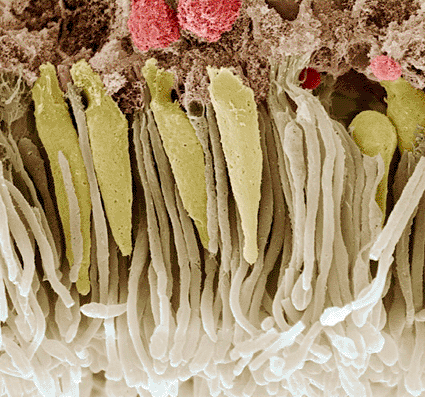Autofluorescence of Cells Provides Early Eye Disease Diagnosis
By MedImaging staff writers
Posted on 27 Feb 2008
Posted on 27 Feb 2008

Image: Colored scanning electron micrograph (SEM) of receptor cells in the human retina, the light-sensitive tissue that lines the inside of the eye (Photo courtesy of the Eye of Science).
Victor M. Elner, M.D., Ph.D., and Howard R. Petty, Ph.D., from the University of Michigan Eye Center (U-M; Ann Arbor, MI, USA) used the instrument to measure the degree a visual condition affected six women. The women had been recently diagnosed with pseudotumor cerebri (PTC), a condition that mimics a brain tumor and often causes increased pressure on the optic nerve that can lead to vision loss.
Because each woman's disease was in a very early stage, the instrument could be accurately appraised compared to several standard tests used to evaluate vision: visual fields, visual acuity, and pupillary light response. In each case, the imaging instrument provided results that were equal to and often superior to the standard tests.
All of the patients with PTC had higher FA values in the eye that was more severely affected. FA values averaged 60% greater in the more affected eye of these women. By contrast, the control group had no significant difference in FA values between their healthy eyes. In addition, FA data more accurately described the different degree of disease in each eye for a given patient, as compared to the standard vision tests.
Dr. Petty, a biophysicist and expert in imaging, explained why FA data is a good predictor of disease, "Cell death can be observed microscopically, but not as yet through any current imaging methods. We believe this study is a big step forward toward creating a diagnostic tool that can characterize disease long before symptoms or visible signs appear.”
The study was reported in the February 2008 Archives of Ophthalmology.
Drs. Elner and Petty have patented the device through the U-M Office of Technology Transfer. They are investigating its use as a screening device in diabetes and other major eye diseases.
Related Links:
University of Michigan Eye Center














